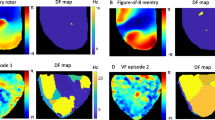The first 10 min of electrically provoked ventricular fibrillation in dogs with ischemic heart disease were characterized by organized myocardial activity evidenced by the dominant ECG frequency structure. During the first 2 min of ventricular fibrillation, low-frequency oscillations (4-7 Hz) dominated, while on min 3 to 10 after the onset of fibrillation, the dominant frequencies were low and medium (4-12 Hz). After 10-min fibrillation, the oscillations became non-dominant. Thus, ischemic myocardium maintains the organized structure of ventricular fibrillation for the first 10 min, which is important for the development of automatic diagnostics of abnormal cardiac activity in humans.
Similar content being viewed by others
References
E. A. Aristakesyan, Evolutionary aspects of interaction of sleep and stress: Phylo- and ontogenetic approach. J. Evol. Biochem. Physiol., 45, No. 6, 724-739 (2009).
S. V. Akhmetzyanova, N. A. Kibler, and V. P. Nyzhny, Electrical properties of the ventricular myocardium under conditions of antiorthostatic hypokinesia. Vrach-Aspirant, 63, No. 2.1, 141-147 (2014).
S. V. Akhmetzyanova, N. A. Kibler, V. P. Nuzhny, N. V. Arteeva, and D. N. Shmakov, Effects of antiorthostatic hypokinesia on the sequence of the myocardial depolarization and repolarization of ventricles and hemodynamic indices of the heart in dog. Izv. Komi Nauch. Tsentra Ural. Otdel. Ross. Akad. Nauk, No. 1, 43-50 (2014).
G. A. Gleizer, N. P. Moskalenko, and M. G. Gleizer, Orthostatic test in clinical practice. Klin. Med., 73, No. 2, 52-54 (1995).
V. S. Markhasin, V. Ya. Izakov, and V. I. Shumakov, Physiological Bases of Myocardial Contractile Dysfunction [in Russian], St. Petersburg (1994).
V. P. Nuzhny, N. A. Kibler, A. S. Tsvetkova, D. N. Shmakov, P. V. Nuzhny, and S. V. Panyko, The combined analysis of the interaction of electrocardiostimulating system and the heart. Izv. Komi Nauch. Tsentra Ural. Otdel. Ross. Akad. Nauk, No. 6, 45-52 (2011).
I. D. Pestov, Basics of Gravitational Biology. in: Space Biology and Medicine [in Russian], Moscow (1997), Vol. 111, Book 1, pp. 46-48.
V. N. Sosnitskii, L. A. Stadnyuk, and T. V. Sosnitskaya, Magnetocardiography: New insights onto old ideas. Serdtse Sudini, No. 4, 73-78 (2004).
A. S. Tsvetkova, N. A. Kibler, Y. E. Azarov, V. P. Nuzhny, and D. N. Shmakov, Repolarization of canine ventricular myocardium under the supraventricular rhythm. Ros. Fiziol. Zh., 94, No. 5, 523-531 (2008).
A. L. Waldo and A. L. Wit, Mechanisms of cardiac arrhythmias. Lancet, 341, 1189-1193 (1993).
Author information
Authors and Affiliations
Corresponding author
Additional information
Translated from Byulleten’ Eksperimental’noi Biologii i Meditsiny, Vol. 161, No. 2, pp. 186-189, February, 2016
An erratum to this article can be found at http://dx.doi.org/10.1007/s10517-016-3498-8.
Rights and permissions
About this article
Cite this article
Guryanov, M.I. Dominant and Non-Dominant Frequency Structure of Evoked Ventricular Fibrillation in Dogs with Myocardial Ischemia. Bull Exp Biol Med 161, 228–231 (2016). https://doi.org/10.1007/s10517-016-3382-6
Received:
Published:
Issue Date:
DOI: https://doi.org/10.1007/s10517-016-3382-6



